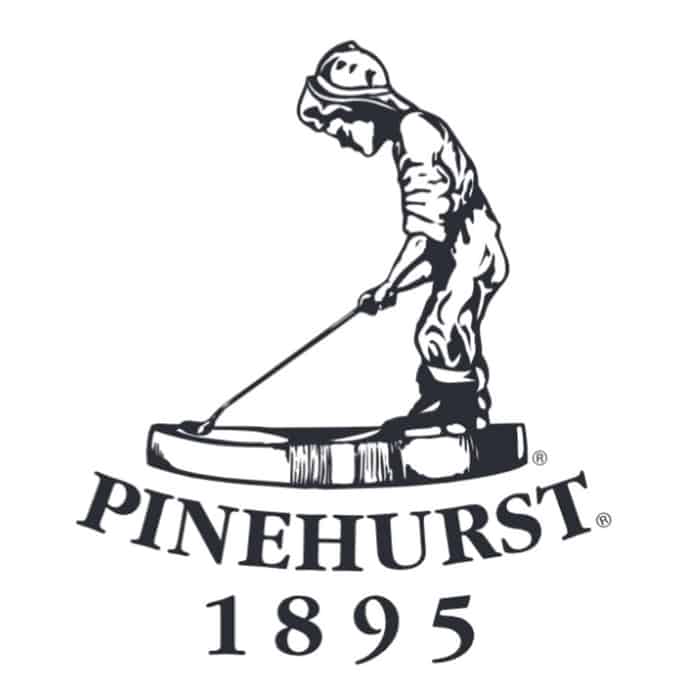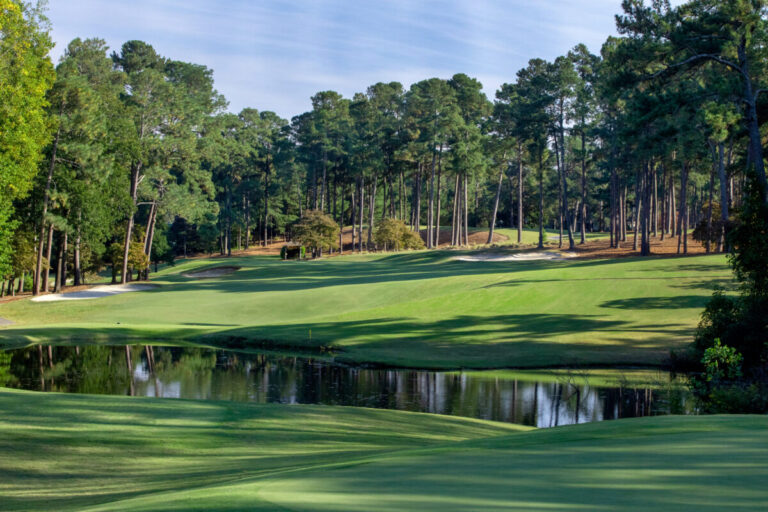Design history & timeline
The first 18 holes at Pinehurst were completed in 1898–99 from two earlier nines: a first nine laid out by Dr. Leroy Culver in 1897 and a second nine by John Dunn Tucker soon after. In 1900–01, a year after arriving in the Sandhills, Donald Ross reshaped and unified those disparate nines into a single, coherent Course No. 1. Contemporary and resort histories agree on the 1901 date of Ross’s reconstruction, framing it as his first substantive design act at Pinehurst. [1]
The course immediately served competitive aims: the inaugural North & South Amateur began on April 1, 1901 on No. 1, then playing 5,176 yards, indicating the club’s desire—realized through Ross’s reworking—to host organized championship play on this compact, unified 18. (This is an inference from timing and usage; the source documents record the date, yardage, and venue.) [2]
Ross’s specific “intent” on No. 1 is not preserved here in quoted minutes or letters, but two institutional sources help triangulate it. The resort’s course page credits Ross with adding bunkers across fairways and around greens, while a reported account of No. 1’s evolution notes that, as early as this phase, bunkers a few yards short of the green and fairway bunkers on the preferred angle became part of the playing vocabulary. Read together, they depict Ross’s purpose on No. 1 as knitting together Culver/Tucker corridors with strategic hazards that controlled angles and trajectories at member scale. (Intent inferred from these corroborating statements.) [3]
Ross remained at Pinehurst for decades, but accessible sources do not document a later, discrete “second phase” by Ross on No. 1 comparable to his serial refinements of No. 2. In absence of explicit records, any claim of later Ross-directed revisions to No. 1 should be treated as unproven. (See Sources & Notes.) [4]
Significant modern alterations followed long after Ross. An early-1980s project (cited specifically as 1981 in later reporting) flattened/tamed the greens, softening earlier domed surfaces; in 2008 the resort completed a $1.7 million upgrade (tees re-built, 419 Bermuda fairways, USGA-spec greens seeded Penn G-2 bentgrass, new irrigation); and in 2012 No. 1 converted its greens to MiniVerde ultradwarf Bermuda and executed a small reroute: a new Bill Coore-designed par-3 9th replaced the old par-3 18th, and the par-5 17th became the finisher. [5]
Unique design characteristics on No. 1
Much of the front-nine journey, particularly holes 3–7, runs along the Pinehurst Harness Track corridor and works with gentle doglegs and elevation changes—a stretch singled out by resort staff as a “perfect mix” that still reads as early-Pinehurst ground game routing rather than bulldozer artifice. (The resort emphasizes that No. 1 was “cut from the land without bulldozers,” underscoring the continuity of those corridors.) [6]
On the inward half, the par-3 12th is repeatedly called out internally for its strategy and setting, with 13 and 14 praised for how they “fit into the contour and elevation changes on the land.” These remarks align with Ross’s 1901 brief on No. 1—using natural rolls to set stances and sightlines and letting greens and bunkers refine the preferred approach. While the precise contours visible today reflect later green work (see below), the playing corridors and elevation-led decisions at 12–14 remain the clearest living expression of the 1901 routing and its intended shot values. [7]
Across No. 1, resort and journalistic descriptions still note two hallmarks as they appear here: bunkers a few yards short of greens that toy with depth perception and trajectory, and fairway bunkers guarding the favored angle into the day’s hole location. On No. 1 these features tend to be modest in size and set to influence club selection rather than to punish indiscriminately—an approach that fits a 6,000-yard member’s course born of late-19th-century corridors and given coherence by Ross in 1901. [8]
Given the 2012 nine/finish adjustment, holes 3–7 and 12–14 present the strongest continuity with the Ross-era plan: the routing sits cleanly on natural tilts, hazards act on angles rather than carries, and green sites (even with later recontouring) still leverage surrounding grades for recovery options typical of early Pinehurst golf. This judgment is consistent with staff commentary and the resort’s statement about minimal earthmoving on No. 1. [9]
Historical significance within Ross’s body of work
No. 1 mattered because it was Ross’s first unifying act at Pinehurst. The 1901 overhaul turned a pair of serviceable nines into a single course capable of staging the resort’s signature event—the North & South Amateur—from its very first playing that same spring. That function set the template for Pinehurst as a competitive venue and helped launch Ross’s long career there. [10]
Modern observers and Pinehurst’s own storytellers portray No. 1 as “often overlooked” relative to its famous sibling, but still valuable as a window into early Pinehurst golf scaled for resort play. This reputational note places No. 1 as historically important—foundational rather than spectacular—in discussions of Ross’s Pinehurst years. [11]
Tournament history on No. 1 is appropriately early-era: the inaugural North & South Amateur (1901) and the early North & South Women’s Amateur (from 1903) used No. 1 (the latter in combination with No. 3), tying the course to the birth of events that have defined the resort’s competitive identity ever since. Later national championships migrated to other courses, especially No. 2, leaving No. 1 with foundational rather than headline championship status. [12]
Current condition / integrity
Routing. Apart from the 2012 change that introduced a new par-3 9th and promoted the former 17th to 18th, No. 1’s routing otherwise tracks the historic corridors, especially along the Harness Track and through the 12–14 pocket. The 2012 work removed the old par-3 18th from play. [13]
Greens. The early-1980s (often specified as 1981) effort flattened/tamed many putting surfaces, reducing the more pronounced domes and false fronts remembered from pre-1980s play. In 2008 the greens were rebuilt to USGA specifications and seeded to Penn G-2 bentgrass, and in 2012 they were converted to MiniVerde ultradwarf Bermuda. As a result, Ross’s green contours are the most altered component of No. 1 today, even while surrounding grades still influence recovery. [14]
Bunkers & presentation. Descriptions of No. 1’s current look stress that it plays as a parkland layout with turf to the tree line, rather than with the broad, sandy wastes associated with the Sandhills; this aesthetic shift occurred over the 20th century as rough and irrigation expanded. (The resort’s wording and agronomy commentary support this characterization.) Strategically, however, fronting bunkers and angle-guarding fairway bunkers remain recurring devices. [15]
Trees & turf. The 2008 work regrassed fairways to 419 Bermuda and the same campaign modernized irrigation; in 2012 the MiniVerde conversion aligned No. 1 with Pinehurst’s move toward heat-tolerant ultradwarf greens. These interventions improved summer performance but necessarily moved the playing surfaces farther from Ross-era grassing. [16]
Integrity summary. With the finishing sequence adjusted in 2012 and the greens materially changed in the early 1980s/2008/2012 projects, the holes most faithful to Ross’s 1901 work are those where the routing and grade-driven strategy do the talking—notably 3–7 and 12–14—while the putting surface contours are largely post-Ross. The bunker vocabulary preserves Ross’s intent even as shapes and maintenance lines reflect later eras. (This assessment synthesizes the resort’s own descriptions and reporting cited above.) [17]
Sources & Notes
1. Village of Pinehurst Neighborhoods—“Timeline History of Pinehurst, Pinehurst Resort and Pinehurst National” (PDF), noting Culver/Tucker 1898–99 and Ross redesign in 1901; Pinehurst No. 1 course page summarizing designers and Ross’s additions. Discrepancy note: the resort page lists “Dr. Leroy Carver,” while multiple histories (including the Village timeline) record Dr. Leroy Culver; Culver is used here. National Property Owners Association, Pinehurst Resort
2. Pinehurst: “History of the North & South Amateur” — documents the April 1, 1901 start on No. 1 at 5,176 yards; early Women’s North & South also used No. 1. Pinehurst Resort
3. Pinehurst No. 1 course page (Ross “added bunkers across fairways and around the greens”); Sports Illustrated (SI.com) travel feature on No. 1 and No. 3 (bunkers a few yards short of greens; angle-guarding fairway bunkers; Ross unified the nines in 1901). (Design intent inferred from these two sources.)
4. Tufts Archives references confirm the archival holdings but do not, in these accessible pages, publish specific No. 1 minutes or Ross correspondence about post-1901 phases; therefore, later Ross work on No. 1 is uncertainin the available record used here.
5. SI.com notes the 1981 “taming” of greens; Carolinas Golf (Spring 2008) details the $1.7M renovation with USGA-spec greens, Penn G-2 bentgrass, 419 Bermuda fairways; Golf Course Architecture (2012) reports the MiniVerde conversion and the Coore-designed par-3 9th, with the old par-3 18th removed and 17 becoming the finisher.
6. Resort blog (2021) quotes staff praising holes 3–7 for doglegs/elevation changes and the Harness Track setting; Resort blog (2022) emphasizes No. 1’s minimal grading profile (“cut from the land without the use of bulldozers”).
7. Resort blog (2021) highlights the par-3 12th for strategy and 13–14 for how they fit the land; used here to identify the clearest surviving examples of Ross’s routing values on No. 1.
8. SI.com (2022) describes No. 1’s fronting and angle bunkering as it plays today—features that, per the resort page, trace to Ross’s 1901 unification.
9. Synthesis from Resort blog (2021, 2022) on holes 12–14 and minimal grading; used to argue for corridor continuity in those stretches. (Interpretive, but grounded in cited remarks.)
10. SI.com on 1901 unification and North & South context; Pinehurst North & South history page on the inaugural event and yardage. SI, Pinehurst Resort
11. SI.com characterizes No. 1 and No. 3 as “often overlooked,” a fair summary of their reputational placement within Ross’s Pinehurst portfolio.
12. Pinehurst North & South history page documents early editions on No. 1 (Men 1901; Women 1903 including No. 1 and No. 3). Pinehurst Resort
13. Golf Course Architecture (2012) on the Bill Coore 9th, the removal of the old par-3 18th, and the 17th becoming the finishing hole.
14. SI.com on the 1981 green softening; Carolinas Golf (2008) on the USGA-spec/Penn G-2 greens; GCA (2012) on MiniVerde conversion.
15. SI.com on the present parkland presentation and loss of broad sandy waste on No. 1; used here to contrast with Ross-era Sandhills textures.
16. Carolinas Golf (2008) (419 Bermuda fairways, irrigation) and GCA (2012) (MiniVerde greens), documenting current turf. Golf Course Architecture
17. Integrity summary is interpretive, built from the specific, sourced facts above (holes singled out by staff, minimal grading, dates and scope of later work).


